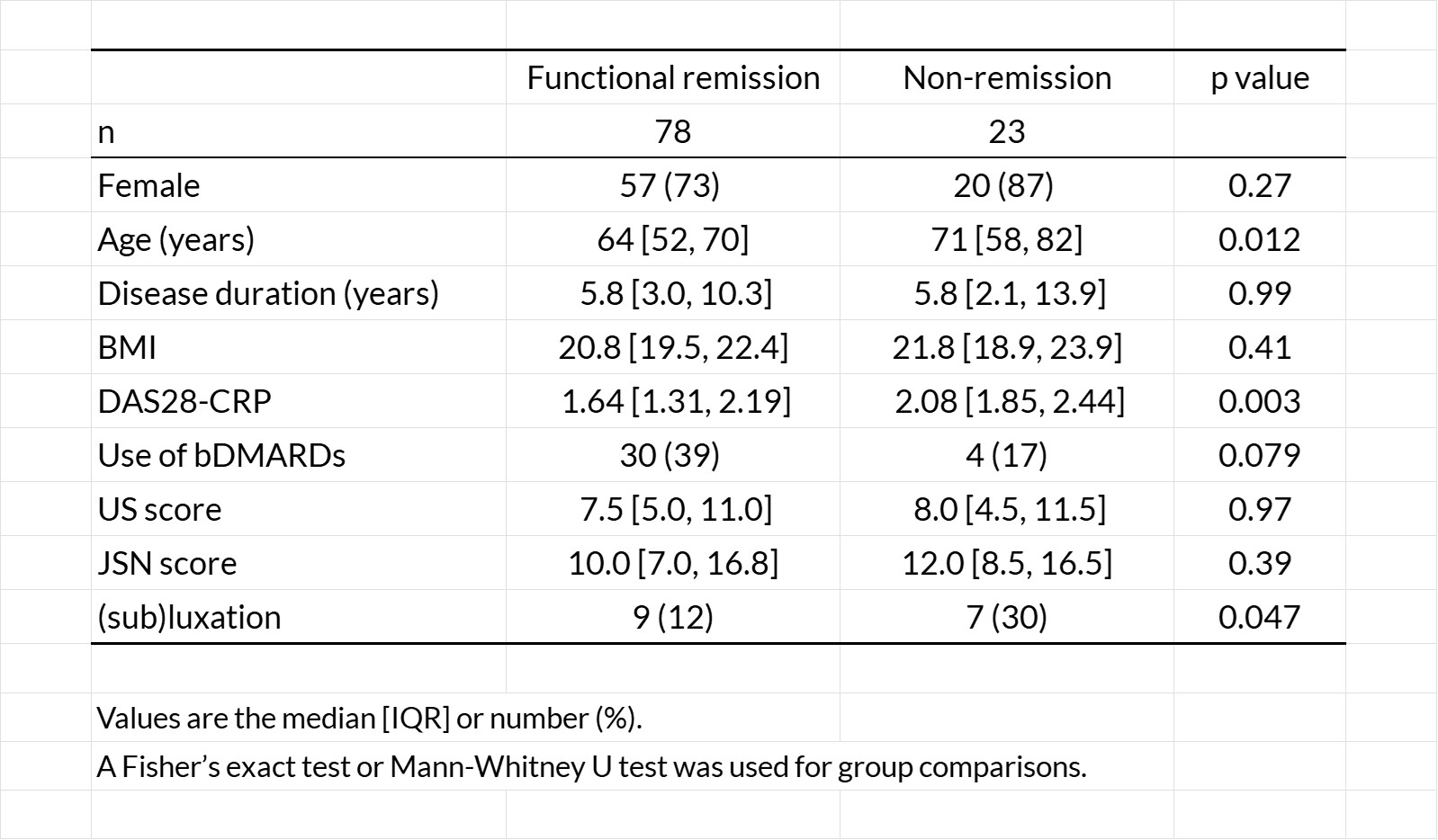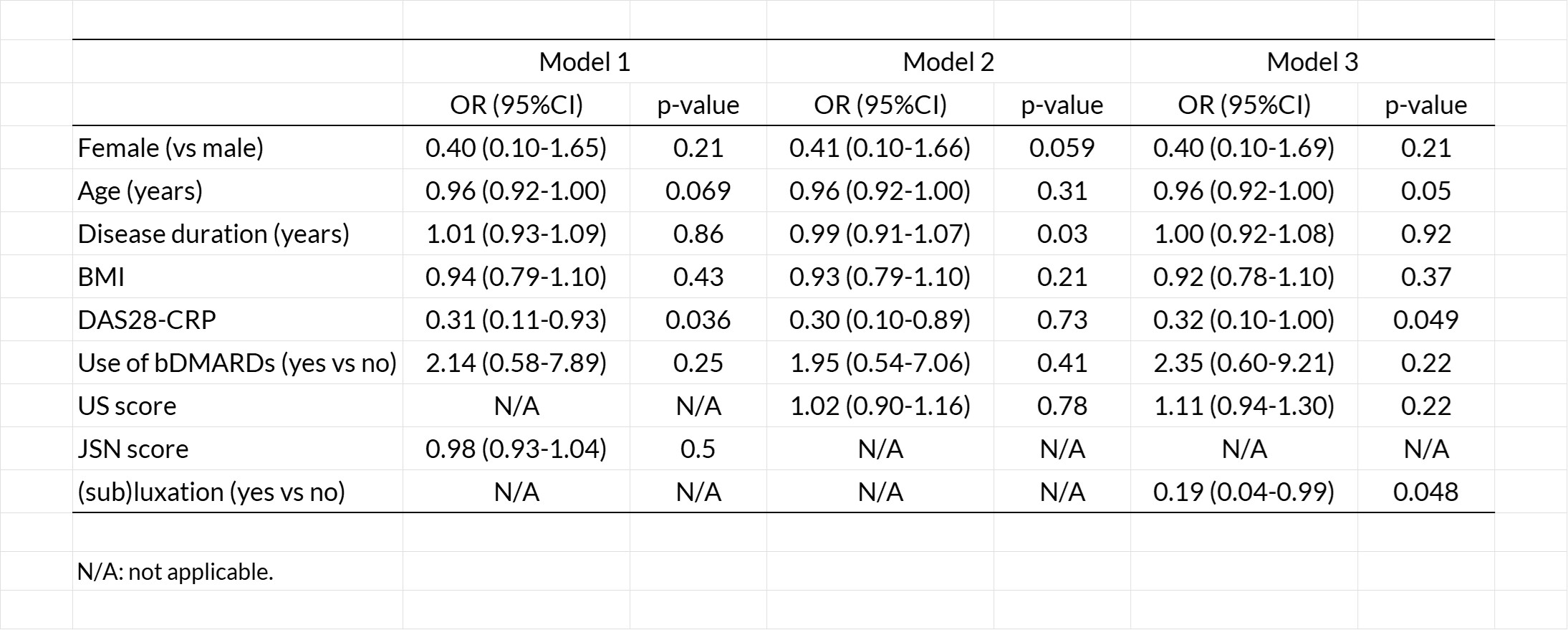Session Information
Session Type: Poster Session A
Session Time: 10:30AM-12:30PM
Background/Purpose: It has been reported that radiographic joint space narrowing (JSN) score affects the health assessment questionnaire-disability index (HAQ-DI) score in rheumatoid arthritis (RA) patients. However, it has not been determined whether cartilage damage or (sub)luxation of small joints predominantly affects the HAQ-DI score. Therefore, we directly evaluated cartilage damage by ultrasonography (US) in addition to radiographic JSN score, and examined their impact on HAQ-DI score.
Methods: Patients with RA in disease activity score (DAS) 28-C-reactive protein (CRP) ≤3.2 were evaluated using the HAQ-DI, the JSN score of the modified total Sharp score by radiographic examination of the bilateral metacarpophalangeal joints and proximal interphalangeal joints of the second to fifth fingers, the presence of dislocation or subluxation, and cartilage by US using a semiquantitative score with a 3-point scale from 0-2. The total score of 16 joints was calculated as the JSN score (maximum score; 64) and US score (maximum score; 32), respectively. HAQ-DI ≤ 0.5 was defined as functional remission, and the functional remission group and non-remission group were compared. Furthermore, logistic regression analysis was performed to include age, gender, disease duration, DAS28-CRP, Body Mass Index, and use of biological disease-modifying antirheumatic drugs (bDMARDs) as explanatory variables for functional remission based on previous studies and univariate analysis.
Results: A total of 101 patients were included. Median age, disease duration, and DAS28-CRP were 64 years, 5.8 years, and 1.71, respectively. The median HAQ-DI was 0.12, and 78 patients (77%) achieved the remission criteria. Comparing function remission and non-remission groups, the remission group was significantly younger and had lower DAS28-CRP, but there was no significant difference in disease duration (Table 1). There were no significant differences in JSN and US scores, and radiographs showed more (sub)luxations in the non-remission group (12% vs. 30%, p=0.047). In the model, including the JSN score (model 1) and US score (model 2), respectively, both JSN score and US score had no significant effect on functional remission, with odds ratios of 0.98 (p=0.50) and 1.02 (p=0.78), respectively (Table 2). However, when the US score and the presence of (sub)luxation were included (model 3), the odds ratio for the presence of (sub)luxation was 0.19 (p=0.048), and it was an independent factor that prevented the achievement of functional remission along with DAS28-CRP.
Conclusion: This study indicates that (sub)luxation of small joints, rather than cartilage damage, affect physical function in RA patients.
To cite this abstract in AMA style:
Ogura T, Minegishi Y, Imaizumi C, Maezawa R, Katagiri T, Kameda H. Cartilage Damage or (sub)luxation of Finger Joints: Impact on Physical Function in Patients with Rheumatoid Arthritis [abstract]. Arthritis Rheumatol. 2024; 76 (suppl 9). https://acrabstracts.org/abstract/cartilage-damage-or-subluxation-of-finger-joints-impact-on-physical-function-in-patients-with-rheumatoid-arthritis/. Accessed .« Back to ACR Convergence 2024
ACR Meeting Abstracts - https://acrabstracts.org/abstract/cartilage-damage-or-subluxation-of-finger-joints-impact-on-physical-function-in-patients-with-rheumatoid-arthritis/


